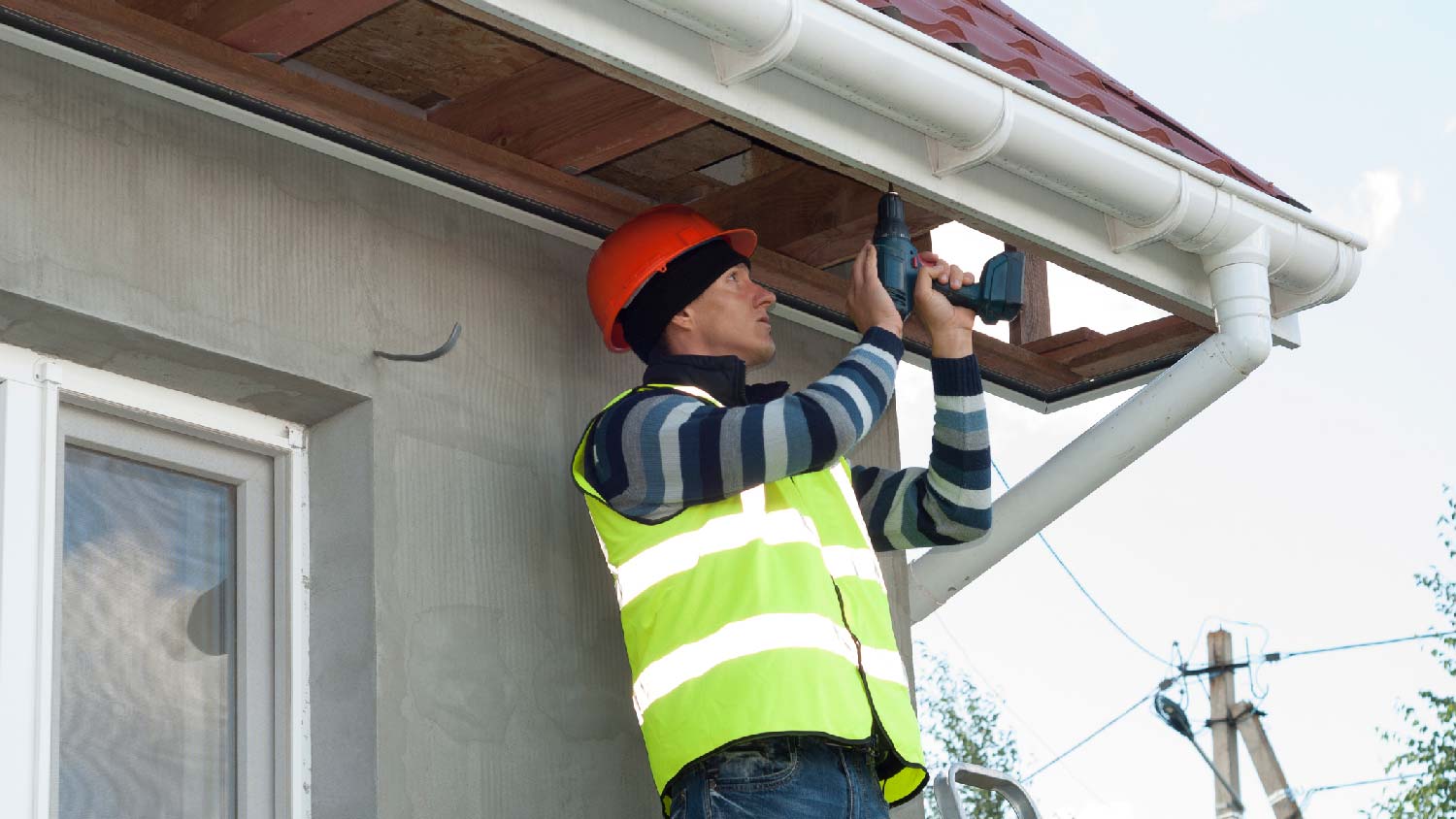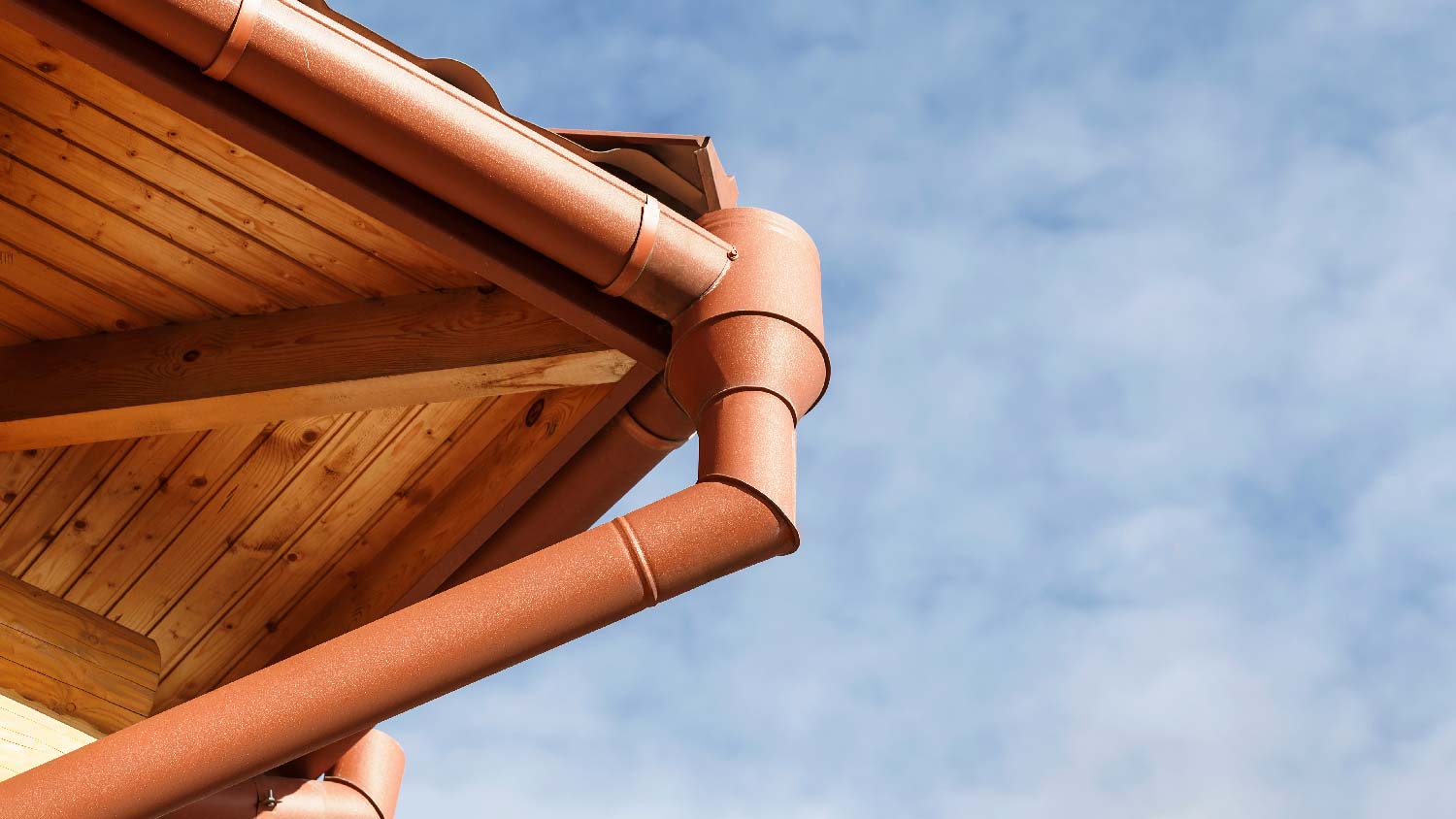Wooden soffits often cost more than other materials, but the aesthetic appeal and real-world materials make up for any sticker shock. While the cost to install wood soffit on an average-sized house is around $1.200, expect a range between $800 and $2.500.
These types of attic vents aren’t as common as less expensive options, but when installed correctly, they can be a subtle and eye-pleasing way to accentuate the lines of your home while providing much-needed fresh air to your attic space.
Woof Soffit Cost Factors
When determining soffit cost factors, remember that wood has a far greater range of costs than aluminum or vinyl soffit. Designer woods like redwood and cedar will always be more expensive than wood composites or engineered wood.
Types
Wood soffits are commonly matched to the material of the house or in a way that compliments it. For example, a white home may look better with pine soffits than redwood. While wood soffits can be painted, they are often left natural. In contemporary home design, it is common to see wooden soffits prominently displayed on the eaves under metal roofs. This really draws the eye to the quality and grain of the wood, and painting it would compromise that aesthetic.
While there are certainly many options to choose from, the majority of wooden soffits are made from pine, cedar, redwood, and engineered wood. For custom-built homes, expect wider soffits made of more expensive wood types. As a broad average, expect to pay around $4 per linear foot, not including labor.
| Type of Wood | Average Cost (Per Linear Foot) |
|---|---|
| Cedar | $2–$5 |
| Redwood | $4–$9 |
| Oak | $4–$10 |
| Teak | $6–$13 |
| Pine | $1–$4 |
| Mahogany | $6–$14 |
| Rare wood types | $8–$25 |
| Engineered wood | $1–$3 |
Size
The number of soffits needed is determined by the square footage of the attic space that needs venting. A good guideline is for every 150 square feet of attic space, you need 1 square foot of ventilation. The issue is that linear feet, which is a unit soffits are sold in, don’t directly line up to square feet, so you’ll need to do some calculations based on the soffits you plan on buying. The average home will require 100 to 250 linear feet of wood soffit, and soffit is commonly sold in lengths between 4 and 12 feet long.
Singular soffits are installed by themselves, and continuous soffits run the entire perimeter of the roof. A common soffit size range is 6 inches to 18 inches wide and 4 feet to 12 feet long for continuous soffits, which, while more expensive, are becoming increasingly more popular.
| Size of Attic in Square Feet | Ventilation Required in Square Feet | Average Cost |
|---|---|---|
| 600 | 4 | $450–$750 |
| 900 | 6 | $600–$900 |
| 1,300 | 9 | $800–$1,100 |
| 1,600 | 11 | $1,000–$1,300 |
| 2,000 | 14 | $1,300–$1,650 |
| 2,600 | 18 | $1,700–$2,400 |
Labor

Photo: MyrKu / iStock / Getty Images Plus / Getty Images
Depending on the complexity of your project and the materials chosen, labor can be 60% of the budget or more. Roofing professionals charge between $40 and $120 per hour, but that number can increase dramatically when specialized equipment or carpentry skills are required. While the labor cost of roof repair averages slightly lower, soffit installation is not as straightforward or standardized.
Location
The location of your roof eaves is a significant factor when determining project cost. It goes without saying that reaching a third-story roof is much more involved than it would be for a single-story home. Anything involving dangerous heights requires specialized equipment, increasing consumer costs.
For particularly hard-to-reach areas, a professional will often opt for a hydraulic lift to access the work area. Hiring a professional is a great way to avoid renting such expensive tools yourself.
Wood Soffit Ongoing Costs
Maintenance
Soffits don’t require a great deal of maintenance. Check them every few months to make sure there aren’t any blockages preventing airflow. If you do this at night, you can use a flashlight to ensure light passes through. You can brush vents that are easy to reach yourself, but a blockage is often caused by someone placing items in the attic over the vents. This is rarely an issue for continuous venting, but for singular vents, covering one could significantly reduce airflow.
Repairs
Repairing wooden soffits is often pretty involved, so it’s a good idea to just remove and replace them. This shouldn’t cost too much in labor if you hire a pro, and you can rest assured that the job is completed well and done safely. Other than material costs, which vary by project, expect to pay $50 to $130 per hour for soffit repair.
DIY Installing Wood Soffits vs. Hiring a Pro
We’ll get right to it—you shouldn’t try this one yourself. There are many DIY home projects to consider, but unfortunately, this isn’t one of them. The combination of technical skill requirements and height challenges leads to many preventable accidents. Even if nothing goes wrong, working at uncomfortable heights means you’ll likely rush the job.
You should hire a local roofing professional to remove or install wooden soffits. While it may seem like a steep price to pay, consider that a pro can actually help you save money as well.
Cost of Common Wood Soffit Add-Ons
Wood soffit installation often goes hand-in-hand with other roofing and drainage projects. Here are some common add-ons when installing wood soffits:
- Fascia installation: $7 to $22 per linear foot
- Exterior lighting installation: $2,000 to $6,000
- Gutter replacement or installation: $4 to $40 per linear foot
- Heating cable installation: $13 to $26 per linear foot
- Soffit painting: $2.50 to $6.50 per linear foot
Tips to Reduce Cost When Installing Wood Soffits

Photo: Maryana / Adobe Stock
There are two factors to consider when looking to reduce price impact: labor and materials. If you are patient and industrious, you can easily rack up double-digit savings on both items. Some tips to reduce cost when installing wood soffits are:
- Hire roofing professionals during their off-season. This isn’t always winter, so ask your pro.
- Ask your professional if they get any preferred pricing on materials.
- Offer to help with any debris removal, cleaning, etc.
- Consider engineered wood that mimics the real thing.
- Look for discounted soffits at second-hand or overstock stores.
- If you have a truck or large van, drive to collect the materials.
How Angi Gets Its Cost Data
Home is the most important place on earth, which is why Angi has helped more than 150 million homeowners transform their houses into homes they adore. To help homeowners with their next project, Angi provides readers with the most accurate cost data and upholds strict editorial standards. We extensively research project costs to develop the pricing data you see, so you can make the best decisions for you and your home. We rely on reputable sources, including the U.S. Bureau of Labor Statistics, academic journals, market studies, and interviews with industry experts—all to ensure our prices reflect real-world projects.
Want to help us improve our cost data? Send us a recent project quote to costquotes@angi.com. Quotes and personal information will not be shared publicly.
Frequently Asked Questions
What is the least expensive material for soffits?
Vinyl is the least expensive material, followed by certain composites. Over time, longer-lasting materials like aluminum can be less expensive if you consider they need replacing less, but the initial lowest-cost option is vinyl. Vinyl offers decent protection and requires almost zero maintenance. The material can be mass-produced and is easily customizable, which keeps costs low. The most expensive options will be rare woods like teak and mahogany and specific metals.
How long do wooden soffits last?
Wooden soffits, when properly cared for, can last between 10 and 25 years, depending on the type of wood and the climate you live in. Certain wood types will last longer than others, and you might want to consider the cost of replacing soffits when you break down the total project cost. While an initially higher-priced material might seem counterintuitive, it can make more financial sense if you don’t plan on moving.
Are soffits necessary?
Soffits are necessary if your attic—or space under your roof—lacks ventilation. Soffits move stale air through the space which prevents mold damage or other side effects of trapped hot air. While you may be able to get away with installing a fan in the attic, it most likely isn’t pulling in enough fresh air to influence the humidity level in the space.
What are the alternatives to soffits?
Fascia and soffits differ in their location and design, but fascia vents are the most popular alternative to soffits. These are a bit more hidden than soffits, but depending on the structure of your roof, they can cost more to install and maintain. They are also installed around the entire roof, whereas soffits can be placed only where you need them or, if the aesthetics bother you, somewhere out of sight.
What are some disadvantages of soffits?
Some disadvantages of soffits are that they can rot and become damaged by adverse weather, but probably the most glaring disadvantage is that they are high off the ground and, therefore, hard to maintain. Although most soffit maintenance only involves ensuring air can pass through, getting to the soffit is the crux of that project.









